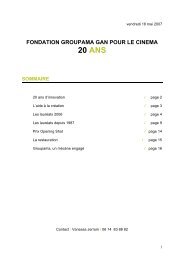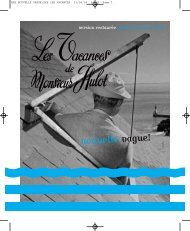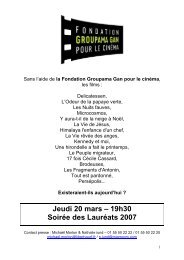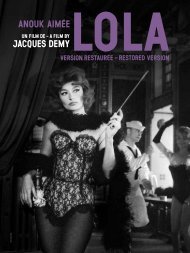duVoyage - Fondation Groupama Gan pour le Cinéma
duVoyage - Fondation Groupama Gan pour le Cinéma
duVoyage - Fondation Groupama Gan pour le Cinéma
Create successful ePaper yourself
Turn your PDF publications into a flip-book with our unique Google optimized e-Paper software.
help Auguste and Louis Lumière (who were making a contribution to the costs) mount a gigantic operation<br />
to the glory of cinema: free showings by the Lumière brothers were organised on a giant screen.<br />
These were greeted extremely favourably by the public. The sca<strong>le</strong> was impressive: a space 6,300 m 2 – the<br />
immense hall or Gal<strong>le</strong>ry of Machines, a vestige of the 1889 Universal Exhibition - was reorganised into a<br />
circular space with four tiered rows of seats ab<strong>le</strong> to accommodate 15,000 peop<strong>le</strong>; a circular stage measured<br />
90m in diameter. It was one of the largest entertainment halls in the world.<br />
« Cinematography on this giant sca<strong>le</strong> needed a great deal of resource and organisation. A 17m long cement<br />
vat, fil<strong>le</strong>d with water, was instal<strong>le</strong>d under the floor. Winches were attached to the metallic building structure<br />
to lift and take down the screen. A 3m wide, 6m long cabin was built in wood and lined with sheet<br />
metal. The screen was extremely large, almost 400m 2 , and had to be removed comp<strong>le</strong>tely in order not to<br />
interfere with other activities taking place in the hall. The general technical and administrative report of<br />
the Exhibition pointed out the following: The screen situated along the longitudinal line of the Champs<br />
de Mars was 21m wide and 18m high. To shelter it from dust, operators placed it after each evening showing<br />
in a cement vat that had been instal<strong>le</strong>d under the hall’s floor and contained water. Half an hour before<br />
each session, the screen was lifted up using a winch that had been placed over the glass roof; when it<br />
was being put up, streams of water washed the screen again. The material it was made of had been chosen<br />
to <strong>le</strong>t pass as much light as was ref<strong>le</strong>cted back; so that the image could be seen on both sides of the screen.<br />
The programme, which lasted 25 minutes, included 15 cinematographic views and 15 colour photographs.<br />
It was changed regularly – 150 films were projected, their tit<strong>le</strong>s unknown since these were not written<br />
in the programme. The sca<strong>le</strong> and the fact that the show was free, demonstrated the Lumières’ desire to<br />
ensure their invention became as widely known as possib<strong>le</strong> and to be officially and internationally recognised<br />
as the inventors of cinema.<br />
There were 326 projection sessions between 15 May and 12 November. In total almost 1 million peop<strong>le</strong> –<br />
from Paris, the provinces and abroad – would have seen the show».<br />
Source Emmanuel<strong>le</strong> Tou<strong>le</strong>t, Cinema at the Universal Exhibition of 1900, Revue d’Histoire moderne et contemporaine, 1986<br />
1900-1905:<br />
The cinema show<br />
The Lumière’s event at the Universal Exhibition showed the public that cinema was not just about new invention,<br />
but could be spectacular. The cinema was no longer just technique, it was about entertainment.<br />
The years that followed would be cinema’s golden age. Films were made for the sake of making them, and<br />
peop<strong>le</strong> would go to the cinema halls, which developed quickly, in the same way that they would go to the<br />
theatre.<br />
Méliès would follow these developments closely – since he had what was needed to appeal to the public<br />
in this period: an artist who could create cinematographic shows. The public were seduced. Méliès’ success<br />
grew with popular films such as The Coronation of Edward VII or A Trip to the Moon, which gave Star<br />
Film worldwide notoriety. There followed dazzling growth, with impressive volumes (Pathé would sometimes<br />
re<strong>le</strong>ase 200 copies of a film).<br />
1905-1907:<br />
Plagiarism and over-production<br />
of mediocre films <strong>le</strong>ading to the crisis of 1907<br />
In 1905, production increased as a result of the success of these shows. Growth was spectacular both in<br />
and outside France, particularly in the United States, which had just put in place the Nickelodeon network<br />
(small projection rooms with low entrance charges increased from June 1905 to number 3000 by 1906 and<br />
10,000 by 1910), boosting American and European growth.<br />
94<br />
Cinema appeared to be a godsend, despite its recent creation and a certain climate of uncertainty (notably<br />
because of the patent war in the United States).<br />
Economic concerns dominated artistry in film and adversely affected quality. Plagiarism became commonplace,<br />
and films became increasingly mediocre. Above all, there was not yet a sufficient number of authors<br />
ab<strong>le</strong> to provide fresh content. Gradually, the public was tiring of the cinema show, and the newly emerging<br />
industry suffered its first major set-back. In the circumstances, Méliès resisted well and continued<br />
to enjoy some success. He was ab<strong>le</strong> to demonstrate the undeniab<strong>le</strong> qualities of authorship which had always<br />
characterised him. In 1906, “The Quatre Cents Farces du diab<strong>le</strong>” was a major hit. He withstood the crisis<br />
of 1907 better than his peers, but remained attached, no matter what, to his fairyta<strong>le</strong> world (féerie): and so<br />
the public finally tired of him too. Unfortunately, Georges was very much in debt because his films, imagined<br />
as real shows, required colossal budgets. In the end, he did not weather the crisis, which hit smal<strong>le</strong>r<br />
structures like his hardest with limited equity.<br />
Pathé, which had benefited from American growth, but was affected nonethe<strong>le</strong>ss by the recession, reacted<br />
first by declaring it would no longer sell but rent films. And it would refresh its subject matter by using<br />
new authors. Cinema theatres existed since 1904, but were always in strong competition with fairgrounds.<br />
But by renting its films, Pathé sounded the death-knell for this old cinema distribution channel, and built<br />
its own cinema theatre network throughout France; Pathé had invented a new economic model which<br />
would allow the industry to overcome the crisis and to transform itself.<br />
MPPC 1908 : facteur de relance de l’industrie<br />
In Paris, Méliès worked night and day in his two Montreuil studios to produce the 1,000 feet (300m) of film<br />
each week required by the MPCC. In 1908, Star Film had more than trip<strong>le</strong>d its production compared with<br />
the previous year. To strengthen his precarious finances, Méliès returned to the stage, giving performances<br />
at the Robert-Houdin theatre.<br />
1909-1913:<br />
Industry changes<br />
In February 1909, the 2 nd International Congress of Film Editors, chaired by Georges Méliès, adopted Edison’s<br />
perforated film as an international standard, making large-sca<strong>le</strong> film rental possib<strong>le</strong>. Small producers,<br />
without large structures, disappeared or were absorbed by larger groups such as Pathé or Gaumont. This<br />
was the case of Méliès, who would fall under the sway of Gaumont, his exclusive distributor from 1909,<br />
and then Pathé in 1911 and 1912. He lost all editorial control over the <strong>le</strong>ngth and structure of his films.<br />
The cinema industry had changed comp<strong>le</strong>tely, following developments driven by the crisis of 1907 and the<br />
Congress of 1909. New authors were entering the scene, such as Max Linder, Cecil B. De Mil<strong>le</strong>, and D.W.<br />
Griffith. Large production companies like Gaumont and Pathé organised and control<strong>le</strong>d the market. In the<br />
United States, the MPCC imposed enormous constraints which only large studios could manage.<br />
In 1913, Méliès was ruined because he had not known how to adapt to this new reality and <strong>le</strong>ave his artisanal<br />
system behind, but had continued to produce high-budget films. He was not ab<strong>le</strong> either to renew<br />
his content and subject matter, in an artistic context which was resolutely different to the one he was<br />
familiar with.<br />
Méliès’ last film, Le Voyage de la Famil<strong>le</strong> Bourrichon, was in fact produced, like all his other films in 1911<br />
and 1912 under Pathé’s total control. None of his later films sold well, the public having grown tired of<br />
his fairies. His last big production (À la conquête du Pô<strong>le</strong>, 1912) was a commercial flop. Méliès ended up<br />
owing a considerab<strong>le</strong> amount of money to Pathé as a result. He was removed from the production of his<br />
last film, a comedy in the Max Linder sty<strong>le</strong>, based on a play by Labiche - to make matters worse, the film<br />
was never distributed by Pathé.<br />
95

















